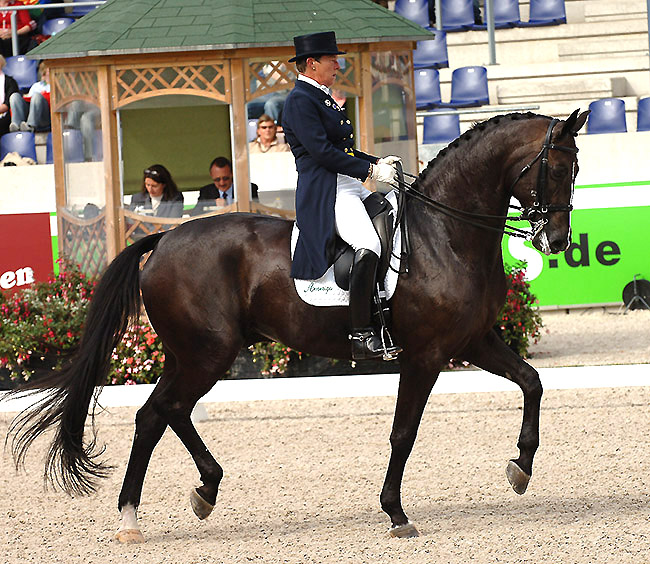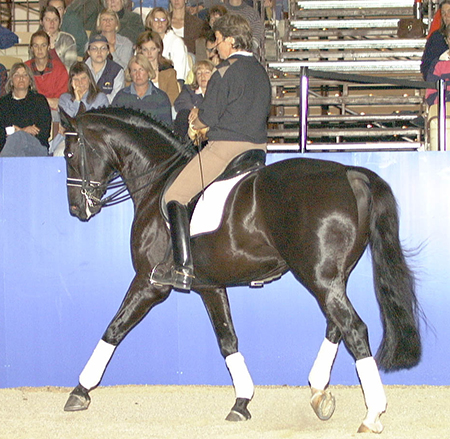Kyra Kyrklund talks about Collection
Kyra Kyrklund is widely acknowledged as one of the world’s great masters of the highly collected movements – piaffe and canter pirouette in particular.
“Before asking for collection, you must teach short steps. Teach with the hand and whip, no leg, and shorten the steps until there is nearly no trot at all.”
“As dressage riders we should all become better at mathematics!”
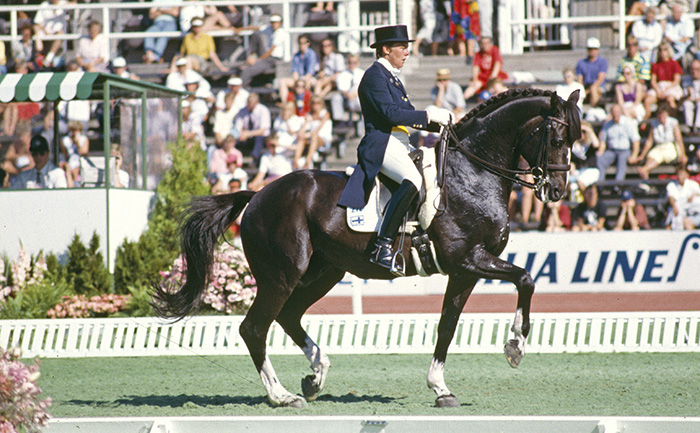
Kyra and the great Matador
At her master class, Kyra demonstrated her technique. She rides between two markers and counts the strides. In this case, 13 steps. Then she rides the same distance in short steps counting as she goes – and it comes up 19 steps. Now, she puts the leg on, and rides it in nine long steps.
“Play with the rhythm, play with the number of steps per minute. It’s the same with the outline, I can put him down as much as I want to, and bring him up as much as I want to. I can ride him fast, and I can ride him slow.”
Once again, Kyra returned to the elusive concept of ‘in front of the leg’.
“Many riders try to get a horse in front of the leg by chasing him, and they will never get there that way. It is best to experience the feeling of in front of the leg with an old school master. You can learn more from a good horse than the best teacher in the world.”
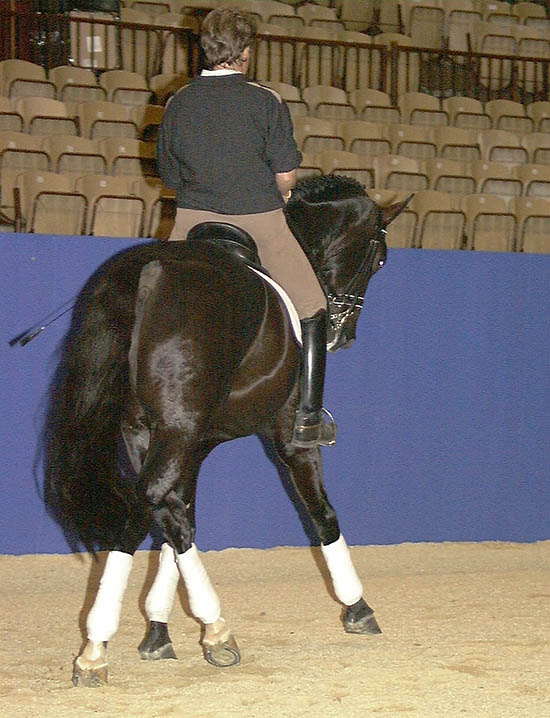
For the walk to canter transition lesson, Kyra returned to the leg yield, really bending the horse around her inside leg. “When I don’t need to push with the inside leg in the leg yield, then I can do the canter transition. Leg yield to canter is a good way to get the horse listening to you. Ask him gently, and if he doesn’t listen try a little kick, and next time, ask gently again.”
Kyra has a new twist on an old ‘truth’.
“You hear very often you have to get strong with your back to use your leg. I think you have to be strong with your tummy to use leg, rather than strong in the back. You have to be able to use your muscles without getting tense. You have to be able to feel what is happening under you. Good riders don’t push down into the saddle, they balance themselves on their seat bones.”
Kyra is an old hand at the lecture demo – and she knew what the Equitana crowd has come to see…
“What you want to see are tricks, tricks, tricks not boring basics. The basics is the work I enjoy. This is how you get scores of 70% in dressage tests – the only way to earn more points is through the quality of your work; that means – proper straightness, proper collection, proper relaxation. You must analyse what is happening with your horse. Is he floppy or is he relaxed? Is he forward or is he tense?”
“It can become puzzling. Your trainer says ride the horse slower, slower, and eventually you ride it too slow. Then you go to another trainer, and they say, go faster, fast, fast, fast – and it works for a while, then you end up going too fast.
Most trainers are heading in the same direction, there are no ‘golden keys’. You just keep trying until you find the way. The more keys you have, the more alternatives to get through to the horse. Horses in principle want to be nice – they don’t stand in the box thinking ‘how can I annoy the rider’.
The trouble is that we tend to memorise the awful times and not that great feeling when we won. Think about it, was a quarter of that circle really good, or was three quarters of the circle really bad? Think about the good feeling, remember it, and then you can make it work for you.”
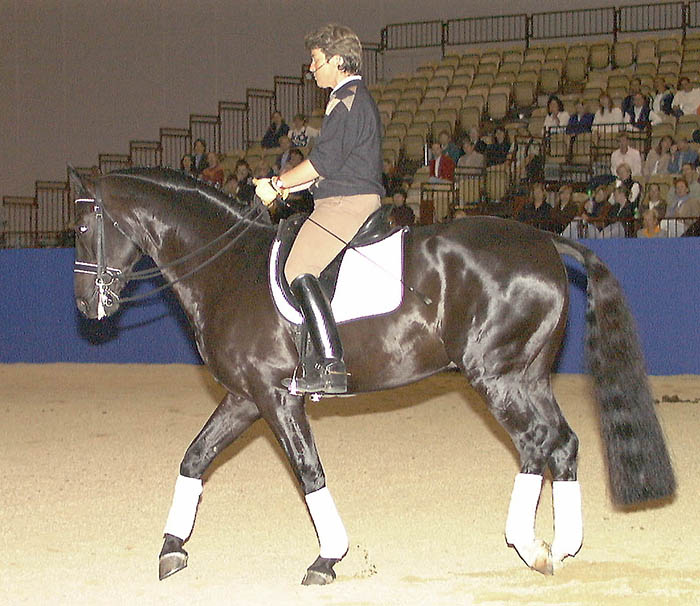
Rasputin shows us the STOP GO routine, stressing that while it is hard to tell if your half halt goes through, it is easy to see if he has stopped or not.
“Half halt is like the rubbish bin of riding – you put all the difficult things in there, and call it half halt. The half halt is not something you learn, it comes from being able to control the frame of the horse.”
Control the frame – and control the leg: “Use your whip like a longer hand, to connect the horse. Make him move more behind, make him bend correctly – the more correctly he bends, then the more he develops the ability to collect. The more collection develops, the more the horse has to bring his legs under him.”
And why do we ask the horse to do two track work? To get his legs under him, and to get him listening to the aids.
“To move on two tracks, the horse has to be listening to the rider’s leg, and I teach that with leg yielding. Some riders think that it is best to rush to half pass, I don’t believe that, half pass comes from listening to the aids. In all lateral work, you have to be careful that the horse moves in the same rhythm and in the same way.”
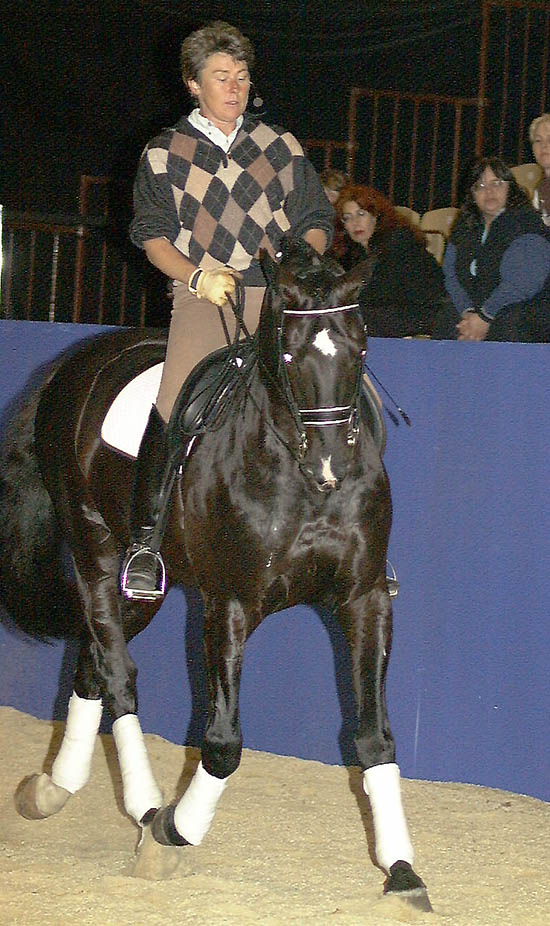
“Shoulder in is fantastic if you really push the shoulders in – not just the quarters out – and soften on the inside rein. Start by riding an eight metre circle, and see if you can keep the track of the hind leg on the track of the outside leg. If you have established connection on the outside rein, then you can ride shoulder in. Remember that leg yielding is only a loosening exercise, while shoulder in is a collecting exercise.”
“When we talk about two track work, there is always a big discussion – should we ride shoulder in on three tracks or four tracks? Three tracks is correct, but if you do the shoulder in only on three tracks, then only one judge out of five, sees it, so you do a bit more! The main thing is not three or four tracks, but if I want to do three tracks or four tracks, I can do it.”
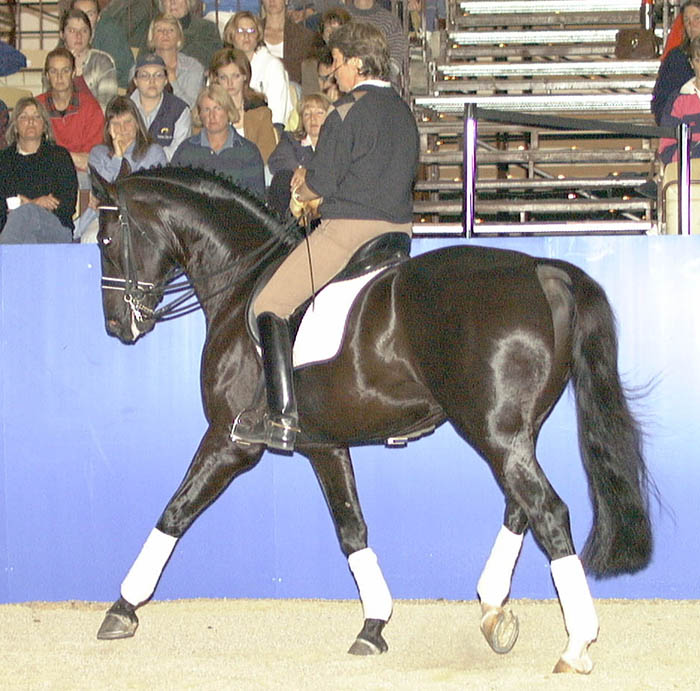
Push the horse out in travers
“To start the shoulder in, ride a little circle, then hold the bend and come out in shoulder in. It’s the same for travers, ride a little circle then hold the line again, and push the horse out in travers. Travers and half pass are exactly the same movement, half pass is just travers on the diagonal. As you come across on the diagonal, the ears have to be the same height, the forehead has to be pointing in the direction we are going. It is the inside leg that pushes the horse forward, and we sit with our weight in the direction of the movement. The inside rein indicates the direction and the outside rein indicates the length of the horse.”
“You have to feel with your bum what is happening behind you. You don’t have a rear vision mirror, and you can’t go looking behind you.”
And of course, with any exercise, there comes a point where the horse finds it difficult – and according to Kyra, this should be another learning experience for both horse and rider.
“When you hit the point when the horse finds it difficult, then many riders try to get it over quickly, they try to do the half pass with more bend, and quicker – that’s not the best thing to do. Cut the exercise up into pieces, first learn to do it slowly in small steps then try it bigger and faster.”
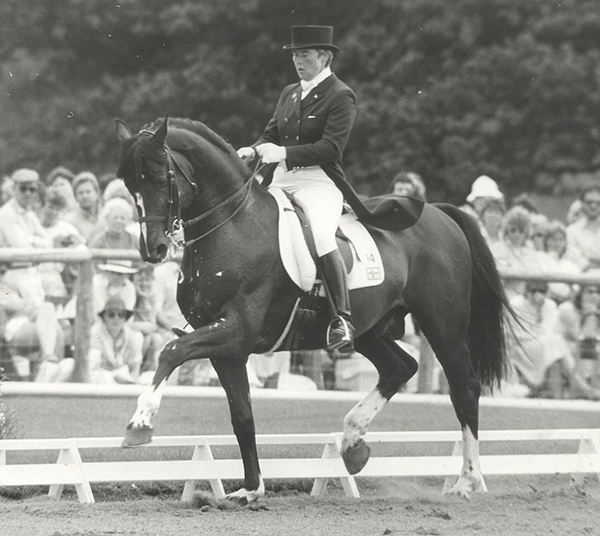
Out of her lateral work, Kyra starts to introduce the flying change:
“Do a few steps of travers on a straight line, then straighten for the flying change. However I suggest that if you haven’t taught flying change before, send the horse to a professional for a few weeks. You should give the aid for the flying change when the inside front leg is on the ground. Your inside leg should be light and floppy with the outside leg keeping the horse cantering forward. Ask for the change with the inside leg and the inside rein, and you can release the old outside rein.”
story continues below the advertisement
Would you like to breed to a top European stallion? Choose from the extensive range available from International Horse Breeders: www.ihb.com.au
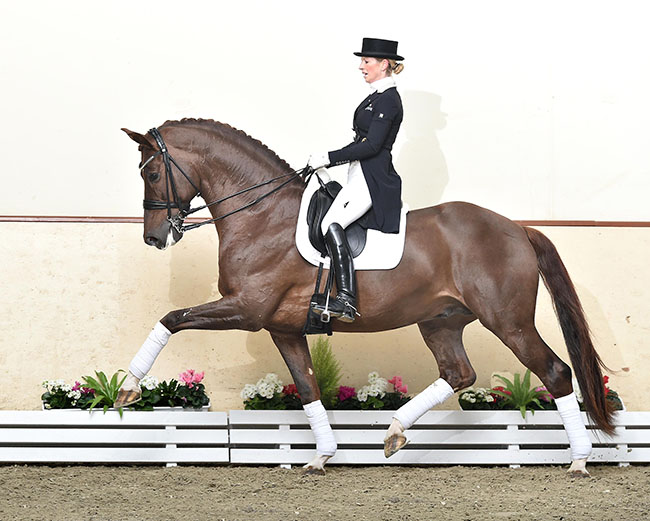
Vitalis
Kyra talks about the Canter Pirouette…
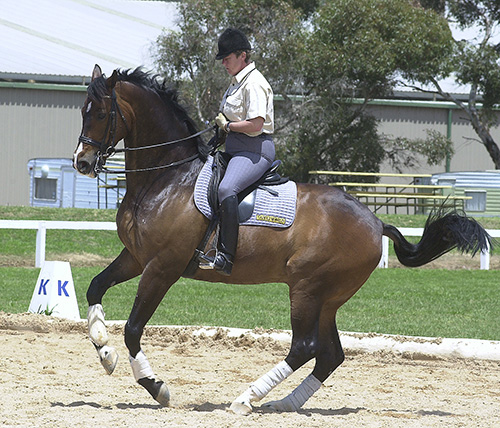
“If you start the canter pirouettes before you have the degree of collection you need, then the horse will become afraid of the pirouette.”
Sounds fairly straightforward doesn’t it? That is until you discover what Kyra considers enough collection!
“You should start your pirouette very very collected like piaffe, almost cantering on the spot but keeping the same rhythm.”
And off they went, the horse getting slower, more like a giant preying mantis with every stride. Walk – give the rein, canter, slow, slow, stop, canter, canter, stop, canter, canter…
“I want him to stretch down with his neck. If the neck is too short, he can’t come up with his hindleg, he can’t bring his tummy up to go with his back.”
“If the horse starts to get on two tracks, go to the wall and ride the exercise in counter canter, then you don’t have to worry about two tracks. You have to sit and make the horse do the work, you can’t get forward in the saddle to try and make him canter, sit back. It is such a fine balance, it is the same as a jumping horse, when you get to the fence you have to release when you see the last stride – think into canter, into canter, into canter. You don’t have a moment of suspension in the pirouette – if you take a photo of the first step of pirouette, it’s the same as a step of piaffe, you can’t tell the difference if it is a good pirouette. That’s why the rhythm in pirouette is a different rhythm than the rhythm of canter – for a long time the judges wouldn’t accept that, but they do now. I only do pirouettes when I feel everything is correct and the horse can do the movement easily. If they do something wrong, then they get worried.”
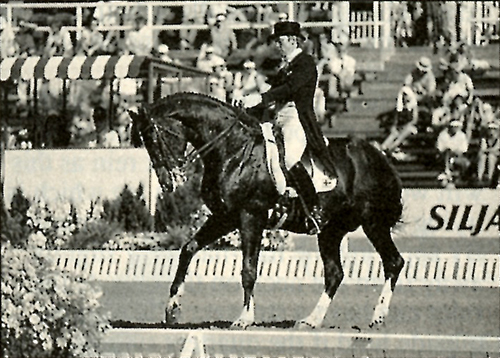
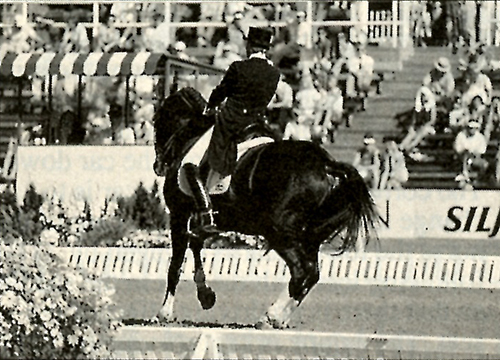
Kyra talks about Piaffe and Passage…
It’s natural. If the horse has been standing in the stable, put him in the paddock and his tail goes up, and passage. We want to keep that energy without getting the horse nervous. We have to be able to shorten and lengthen the step, without getting stuck in our hand, without riding backwards.”
“If he is pulling in passage, then I don’t ask more. I just stay in the same steps until he stops pulling on my hand. I will ask for less passage, shorter steps, until he is doing it, then I can ask for more again.”
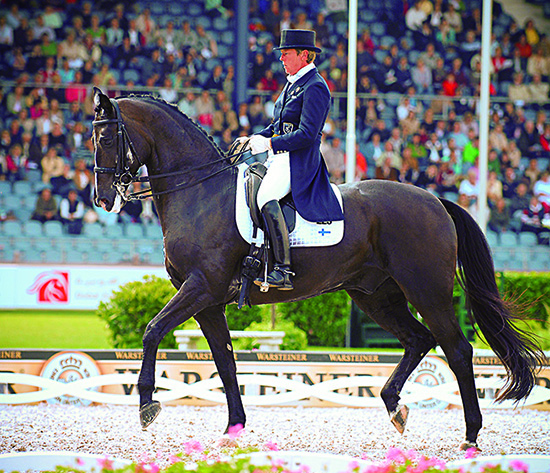
Kyra and Max in passage at the 2006 WEG
“Some horses have more ability for collection than others. Some horses are built with their hocks out behind them, and they find it very difficult to come under for piaffe and passage. Horses that stand with their legs under themselves, may not be so good for extended trot but they will be easier in piaffe and passage. Horses with the biggest trot are not necessarily the best dressage horses. We call it an ‘expensive’ trot because that is what you pay for, but the horses with those trots are not necessarily the best horses for Grand Prix.”
“I had a wonderful Prix St Georges horse but if I tried to make him do Grand Prix, I would only break him by trying to force him to do something he couldn’t do. I decided I’d rather have a sound Prix St Georges horse than a crazy Grand Prix horse. Some horses are not destined for piaffe. Some horses you can see it when they are three or four, will do piaffe easily.”
“For passage, start with very short steps, don’t use your leg, let your leg go completely floppy. Keep him straight, so we get three bad, bad, bad, steps, then five good ones – it’s those five good ones that I go for again. It’s a bit like making tea, you have to get to boiling point without making him tense. When I have passage that I don’t have to work for every step, then it is time to go to piaffe.”
“Boil the kettle again, getting his hind leg under his body, still loose in my hand, I sit with a relaxed leg so he will listen, it is more like kicking with the lower leg than squeezing.”
“When Matador offered piaffe in the forest when he was four years old, I didn’t tell him off, and he did a lovely piaffe when he was five. People ask, what level is your horse? And I say, between Elementary and Grand Prix.”
“You pick the things a horse is good at, and as it becomes stronger, the weaker things become better. When the canter is stronger, then the changes get better. I started the first changes with Matador at six, and he did his first Grand Prix when he was seven, but then the flying changes improved. You try and make it easy for the horse. If you over-train the ones times flying changes, they get worse.”
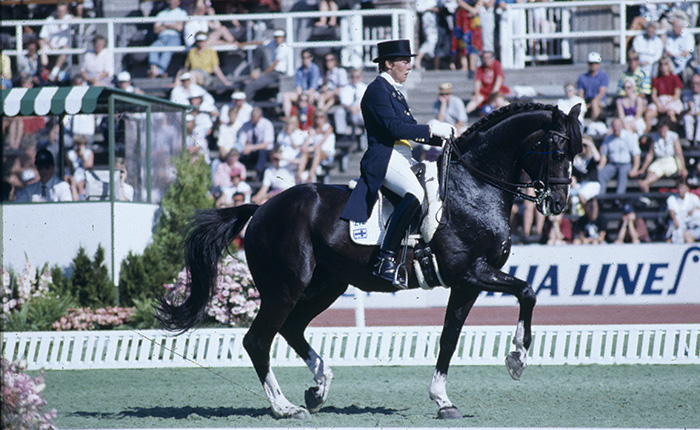
ends



